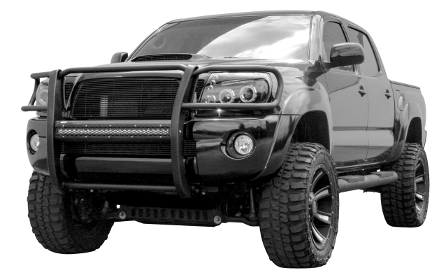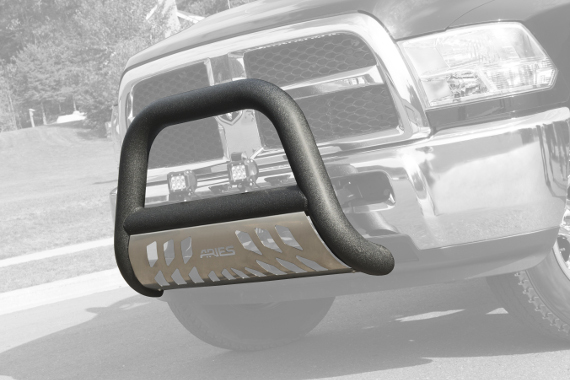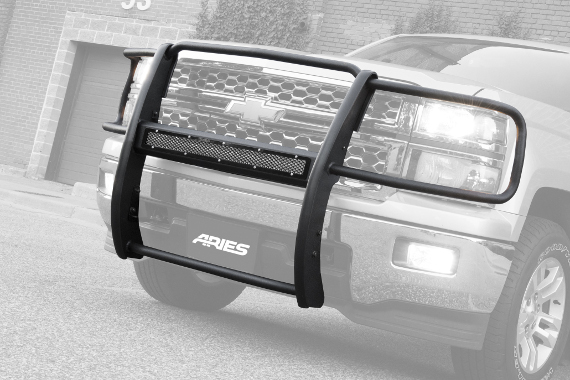

Bull Bars vs. Grille Guards Explained
When it comes to protecting your truck's front end, bull bars and grille guards are two popular options that offer distinct advantages.
In this guide, we’ll discuss the key differences between bull bars and grille guards to help you make an informed buying decision. We’ll cover the following:
- Basic definitions
- Pros and cons of each
- Which vehicles each accessory is best suited for
- Cost differences
- Installation differences
- Other accessory considerations
When it comes to protecting your truck's front end, bull bars and grille guards are two popular options that offer distinct advantages.
In this guide, we’ll discuss the key differences between bull bars and grille guards to help you make an informed buying decision.


What is a Bull Bar?
Let’s start with a basic definition. A bull bar is a front-end truck accessory that’s generally designed with an A-shaped frame. It consists of a main outer tube and a center, horizontal tube (also known as crossbar or cross-member). The main tube extends up from the underside of the vehicle to cover a portion of the bumper and grille, depending on the model.
Typically, a bull bar bolts onto the vehicle's frame and covers just the center portion of the vehicle's front end, as opposed to guarding the headlights as well.
Bull bars are mainly found on pickup trucks, Jeeps, SUVs and even crossover vehicles. Many come with a crossbar that can accept aftermarket lights, as well as a skid plate that attaches to the lower portion of the frame to deflect stones and other small road debris.
What is a Grille Guard?
If bull bars have an A-shaped frame, grille guards could be said to have an H- or T-shaped frame. A grille guard (sometimes referred to as a brush guard) is essentially made up of two vertical members, called risers, and a center horizontal member, called a crossbar, center flange or cross-member. The risers are usually equipped with mounting holes to attach the grille guard to the vehicle frame.
Most grille guards also have a pair of side brush guards or rings attached to the risers that extend outward to protect the vehicle's headlights, as well as a top tube and bottom tube spanning between the risers.
Like on a bull bar, the grille guard crossbar is typically designed to accept aftermarket lights, whether using pre-drilled holes or an LED light bar housing such as on the ARIES Pro Series™ grille guard.


Pros & Cons of Bull Bars
Now that we’ve defined what each accessory is, let’s get into some of the key advantages and disadvantages of each.
Bull Bar Pros:
- Adds an aggressive aftermarket look to your vehicle
- Vehicle-specific designs ensure a custom fit without drilling on most models
- Many unique styles, materials and finishes to choose from to fit your ride
- Adds extra protection to the front end against minor debris
- Can accommodate aftermarket lights for enhanced visibility
- Skid plate attachment deflects stones and road debris, helping to protect the vehicle's underside
- Relatively easy installation process with no drilling required for most models
Bull Bar Cons:
- Generally covers less area compared to a grille guard
- Lacks side brush guards to cover headlights, leaving them more vulnerable to damage
- Can add weight to the front end of the vehicle, affecting fuel efficiency
- May not be legal in all regions
Bull Bar Overview Video
Pros & Cons of Grille Guards
Grille Guards Pros:
- Provides more comprehensive coverage, enveloping a larger portion of the front end
- Equipped with brush guards to wrap around headlights, offering enhanced protection
- Offers a sturdy H-shaped frame design for greater strength and durability
- Mounting holes on the risers facilitate easy attachment to the vehicle's frame
- Crossbar usually designed to accept aftermarket lights, including LED light bars
- Custom vehicle-specific designs ensure a seamless fit without drilling on most models
- Available in various material and finish options
- Enhances the aftermarket look of trucks, Jeeps and SUVs while adding extra protection
- Some models, like the ARIES Pro Series™, feature interchangeable cover plates for customization
Grille Guards Cons:
- Lacks a skid plate, potentially leaving the vehicle's underside more vulnerable to damage
- Installation may require more effort compared to a bull bar due to the larger size and additional components
- Can add weight to the front end of the vehicle, affecting fuel efficiency
- May alter the aerodynamics of the vehicle, impacting performance
- May not be legal in all regions
Grille Guard Overview Video
Bull Bar vs. Grille Guard by Vehicle Type
Best Vehicles for Bull Bars
Bull bars are tailor-made for vehicles that prioritize style and aesthetics, lending a rugged and commanding presence to trucks, 4x4s, Jeeps, SUVs and CUVs alike.
Crafted mainly for their visual aesthetic, bull bars offer some extra protection, but their primary purpose is to elevate the overall appearance of the vehicle. Their sleek and stylish design adds an aggressive look to the front end, enhancing its visual appeal on both urban streets and off-road trails.
That said, bull bars are not ideal if you’re looking for maximum front-end protection. They’re about form over function and are the go-to choice for drivers who are seeking to make a bold statement with their vehicle. If you drive a work truck or own a fleet of commercial trucks, a bull bar may not be your best accessory choice. If you’re looking to turn your stock pickup into a sick build that will turn heads, this is definitely the accessory for you.


Best Vehicles for Grille Guards
Grille guards, on the other hand, are a more balanced combination of form and function. They are designed for vehicles that require extra protection against challenging environments, while still maintaining a stylish, aftermarket look.
Ideally suited for tough trucks, rugged SUVs and adventurous Jeeps, grille guards boast a robust construction designed to withstand harsh conditions. With their H-shaped frame, featuring vertical risers and horizontal crossbars, as well as the side brush guards safeguarding the headlights, a grille guard wraps a larger portion of the front end compared to bull bars.
Whether venturing into a remote wilderness or simply cruising down Main Street, grille guards provide the best of both worlds for drivers seeking durability and an aggressive, aftermarket look for their vehicle.


Cost Difference between Bull Bars & Grille Guards
In general, bull bars tend to be more affordable compared to grille guards due to differences in design complexity and materials used. Bull bars typically feature a simpler A-shaped frame and cover a smaller area of the front end, resulting in lower production costs. Additionally, bull bars often lack certain features, such as brush guards for headlights, further contributing to their lower price point.
On the other hand, grille guards boast a more elaborate frame design with additional components like side brush guards and a larger coverage area, leading to higher manufacturing costs. The inclusion of a bumper within the grille guard design can also raise the cost.
In either case, the overall price of your front-end accessory will be affected by the material and finish type. Bull bars and grille guards made from premium materials like stainless steel will be characteristically more expensive than those made from regular steel. Quality powder-coated accessories will be pricier than cheaply painted alternatives, but you’ll also get what you pay for in terms of durability and appearance.


Installation Difference between Bull Bars & Grille Guards
The installation process for both bull bars and grille guards involves several steps, but there are key differences in the procedures and hardware required.
Installing a bull bar typically begins with the removal of factory tow hooks, if equipped, and may involve cutting out sections of the plastic bumper insert or fascia to accommodate the mounting brackets. The bull bar is then attached to the brackets using bolts, washers, and nuts. Alignment adjustments are made before fully tightening the hardware.
Installing a grille guard typically follows a similar set of steps, involving the removal of tow hooks, trimming out sections of the bumper insert or fascia, and bolting on the mounting brackets. However, grille guards oftentimes have a four-point mounting system, meaning an additional set of brackets is used to anchor the frame to the vehicle. This requires additional hardware installation. Another difference is that some grille guards require the side brush guards to be assembled onto the main frame before being installed on the vehicle. As a final step, some alignment adjustments will likely need to be made before fully tightening the hardware.
Example Bull Bar Installation Video
Complementing Other Accessories
We’ve all seen that pickup truck rumbling down the road looking like a hodge-podge of random accessories all thrown together — the front-end doesn’t match the running boards, which don’t match the headache rack, which is ill-fitted for the tool box.
One final point to consider when deciding between a bull bar and a grille guard is what other accessories your truck has or which ones you might purchase later on. If you want your truck to have a cohesive look and feel, we recommend choosing accessories that complement each other. If you have a stainless steel grille guard, carbide black powder-coated running boards might not be the best fit. If you have a classic headache rack installed, an edgy-looking bull bar might not have the effect you’re looking for.
One of the best ways to give your truck a cohesive look is to select accessories from a series. The ARIES AdvantEDGE series, for example, includes a bull bar, headache rack and steps, all with an angular tube profile and aluminum construction. You can choose from a silver or black powder coat finish.


Disclaimer: These photographs, recommendations, and approximations are intended for demonstration purposes only and do not reflect the specifications of any particular vehicle. Always consult the manufacturer’s Owner's Manual.
Auto Accessories 101 - Bull Bars vs. Grille Guards
< Back to Auto Accessories Guide

3. Bull Bars vs. Grille Guards
4. Side Bars vs. Running Boards
5. Advantages of a Track Mounting System
6. Rocker Mount vs. Bushing Mount
Bull Bars vs. Grille Guards
The ARIES line includes both bull bars and grille guards, including our patented AdvantEDGE® bull bar and Pro Series™ grille guard. When deciding which accessory to select for your vehicle, it is important to know some of the differences.
A bull bar is generally designed with an A-shaped frame, consisting of a main outer tube and a center, horizontal tube or crossbar. The main tube extends up from the underside of the vehicle to cover a portion of the bumper and grille, depending on the model. Typically, a bull bar bolts onto the vehicle's frame and covers just the center portion of the vehicle's front end, as opposed to the headlights.
Bull bars are mainly found on pickup trucks, Jeeps, SUVs and even crossover vehicles. Many come with a crossbar that can accept aftermarket lights, as well as a skid plate that attaches to the lower portion of the frame to deflect stones and other small road debris.
Bull bars are different from grille guards because they:
- Generally cover less area that grille guards
- Do not have brush guards to cover the headlights
- Usually come with a skid plate
If bull bars have an A-shaped frame, grille guards could be said to have an H-shaped frame. A grille guard (sometimes referred to as a brush guard) is essentially made up of two vertical members, called risers, and a center, horizontal member, called a crossbar or center flange. The risers are usually equipped with mounting holes to attach the grille guard to the frame.
Most grille guards also have a pair of side brush guards or rings attached to the risers that extend outward to protect the vehicle's headlights, as well as a top tube and bottom tube spanning between the risers.
Like on a bull bar, the grille guard crossbar is typically designed to accept aftermarket lights, whether using pre-drilled holes or an LED light bar housing such as on the ARIES Pro Series™ grille guard.
Grille guards are different from bull bars because they:
- Generall cover a larger portion of the front end
- Have brush guards to wrap around the headlights
- Do not have a skid plate
Continue to Side Bars vs. Running Boards >
 ARIES
ARIES  CURT
CURT  LUVERNE
LUVERNE  UWS
UWS 





